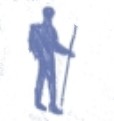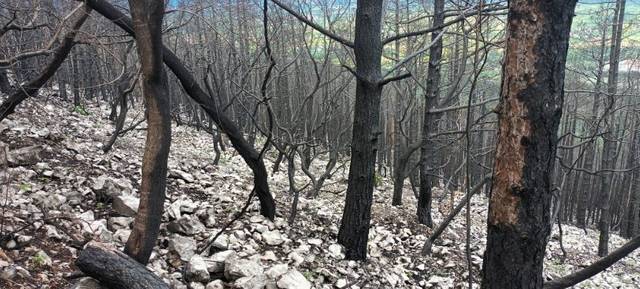Published in Dark Mountain
October 2022
An old man with a wheelbarrow pointed up towards the hill. ‘It was fire everywhere. And bombs. From First War. Bad.’ On a smudged mobile screen he showed me wobbly footage of a opaque, gritty wall of smoke underneath a yellow sky, the sun choked, his friends and neighbours gathered in small frightened herds. Gazing at the burning woods above their village, waiting.
Now, six weeks afterwards, those woods looked like calligraphy: still green in parts, flecked with orange, patched with random blobs of black that splashed and spilled across the hill, like something almost legible. But there were actual letters too, a name, spelled out in stones. TITO. As in Josip Broz, dictator of the former Socialist Federal Republic of Yugoslavia, an entity – like those woods – that now lies in ashes.
I walked up to that TITO sign, a steep climb up a winding road, through a charred cathedral of resinous, twisted stumps. The flames had been specific, touching one tree and not the next, flash-frying the needles of the pines to an eerie umber here, sparing a green branch there, while everything else was black. The soil was black. The rocks were black. Downed cables from a power-line were draped from the charred canopy. But the stones that spelled that name were white, unscorched by flames.
There are other signs like this in what is now Slovenia, particularly in the south-west, which borders Italy. Italians answered them with their own VIVA ITALIA! signs, a silent shouting match conducted across no man’s land. Even before the wildfires, this was troubled ground. Before this was Slovenia, before this was Yugoslavia, it was a province of the Austro-Hungarian Empire, invaded in 1915 by an expansionist Italy. Between then and 1917 – in the ‘First War’, as the old man said – Italian and Austro-Hungarian troops fought twelve brutal battles here, entrenched on rocky slopes and tunnelled into mountainsides. Over 1.5 million men were killed or maimed.
After the war, despite losing every battle, Italy took the land anyway, and ethnic Slovenians were persecuted under Fascism. Mussolini declared a nearby mountain, Sabotin, a zona sacra (sacred zone) and went on a megalomaniacal spree of building giant ossuaries to house the bones of the glorious dead – the Italian dead, of course. The landscape in effect became a vast mausoleum. Then came the ‘Second War’, cycles of murderous revenge, Nazi invasion and entire villages razed. Later this became the front line between communism and capitalism. The last deaths on that border occurred in 1991: two Romanians gunned down by Yugoslav border guards. Today, at last, there is peace.
Or rather, peace and fire.
The giant T, I, T and O lay in a broad clear-cut so the letters could be seen from the valley far below. The socialist strongman’s name had acted as a firebreak. If that was a symbol of anything, it was hard to know quite what. But there could be no better symbol than the bombs.
For ten days I had walked through the Julian Alps to the north following a trail called the Pot Miru (Walk of Peace). The pathway traces the front line of the old Isonzo Front, connecting trenches, fortifications, underground cave networks, cemeteries, charnel houses and monuments to the fallen. There was war iron everywhere: rusted vehicle parts, shell casings, anonymous lumps of scrap and century-old barbed wire tangled in the earth like thorns. I had seen the roots of trees enveloping flattened ration tins, the rich loam of beech forests consuming what was left behind. Unknown tonnes of ordinance were thinly buried beneath my boots, forgotten about for a hundred years.
When this summer’s fires came, they were remembered.
The 2022 wildfires were the worst in Slovenia’s history. Starting over the border in Italy – an odd historical resonance – they quickly spread across the Karst, the pine-covered limestone plateau between the mountains and the sea, and burned for 17 days, destroying 350,000 hectares of forest. Miraculously no one died. Correction: no humans died. But the roll call of animals – foxes, boar, jackals, rodents, snakes, lizards, insects, birds and all the other living things that could not escape the flames – must easily have dwarfed the bones in Mussolini’s ossuaries. An unprecedented drought and the region’s notorious Bora wind made the inferno bad enough, but it was exacerbated by First World War shells and grenades randomly exploding in the intense heat of the flames.

In a village called Kostanjevica, on the far side of that blackened hill, I met one of the firefighters who had helped to stop the fire. ‘It was a war zone,’ he said. ‘We worked in twelve-hour shifts. The flames reached 40 metres high, you couldn’t see anything at all. There were bombs exploding all the time, it meant we could not fight the fire because they could be anywhere. How many? I have no idea. After 70 we stopped counting.’
He was from Pannonia, the region bordering western Hungary, unused to this mountainous terrain. Six weeks later, he had returned for a commemoration. In the centre of Kostanjevica 400 T-shirts hung on lines, each of them a tribute to one of the volunteer fire departments that had been assembled from every part of Slovenia – along with aircraft and other support from Italy, Austria, Hungary, Slovakia, Croatia and Serbia, countries that had once sent their children to fight and die here. The T-shirts flapped like prayer flags, which in a way they were. The word HVALA (THANKS) was painted in big letters on the road.
When the smoke had cleared, much of the Karst had reverted to a battlefield, with trenches and shell craters exposed beneath black, shattered stumps. It reminded me of lines from Ernest Hemingway’s A Farewell to Arms, which is set exactly here, amid the carnage of that front: ‘The forest of oak trees on the mountain beyond the town was gone. The forest had been green in the summer when we had come into the town but now there were the stumps and the broken trunks and the ground torn up.’ Now it seemed that fictionalised history had returned as modern fact. It was, the firefighter later said, like the war had never gone away.
Of course, as the cliche goes, there is no ‘away’. Nothing goes anywhere – especially not the past. At first I thought that this summer’s fires connected things that were far apart: the buried violence of Europe’s past and anthropogenic climate change. Things that were separate and distinct, with hard borders like Yugoslavia. But a border didn’t stop the flames. And borders won’t stop the future. The global heating that caused the drought that made these forests vulnerable, that turned their timber tinder-dry, was fuelled by the 20th-century drive for empire, industrialisation, progress, oil, gas and steel – the smog of war and wildfires is the same cloud, intermingled. Some other lines of Hemingway’s: ‘Perhaps wars weren’t won anymore. Maybe they went on forever. Maybe it was another Hundred Years’ War.’ He was right, but war takes different forms. The war on nature has lasted much more than a hundred years.
As I walked the Walk of Peace I regularly experienced cognitive dissonance, a disconnect between the beauty and the horror that lay beneath. My path led over mountain peaks, into valleys deep and cool with beech, along pristine rivers of an unimaginable emerald green, past gorges, roaring waterfalls and alpine meadows bright with flowers, and picture-perfect villages draped in grapevine and carnations. But that Edenic beauty lay on top of devastation. Of course this is nothing new – we know all life is built from death. But perhaps the fires burned away a veil of separation. Fire rips through layers of time, collapsing not just centuries but compacted billions of years – carbon fuels are sunlight stored since the time of dinosaurs. Everything is being revealed, all the death that never went away. Apocalypse (apokalupsis) means ‘revelation’.
Some days before the trail arrived at the scorched hillside of the TITO sign, it had led me over a mountain called Mrzli Vrh. Here was another battlefield, one of the most notorious, and – unlike in other parts where beauty had restored itself – this one really felt like it, as if the earth beneath me had never quite recovered. I lost my way in pastureland where the ground was shattered and disturbed, a mess of broken rock, fallen trees and spoil heaps, littered with rusted scraps of iron and scarred with old trenches. Across this strategic slope Italian and Austro-Hungarian troops had fought for 29 months, in trenches only 20 metres apart, with machine guns, mines, poison gas, bayonets and flamethrowers. To protect themselves from the constant shelling they slept underground in caves.
In one of those caves – a tunnel gouged into the rock by Hungarian troops – I found a concrete altar inscribed with the Magyar words SZŰZANYÁNK MÁRIA LÉGY NÉPED OLTALMA: OUR MOTHER MARY BE THE PROTECTOR OF YOUR PEOPLE. Above it, among guttered candles, stood a statue of the Virgin. By that time I had been inured to tales of horror from the war, but something about her being there affected me quite deeply. The image of those weary men lying in filth and darkness, frightened, maimed, suffering, such a long way – like that firefighter – from the Pannonian flatlands of their home, waiting in this womb of rock only to emerge to die, placing a statue of a kind woman in an alcove here, lighting candles around her and presenting her with flowers.
Not far along the beech-wood road above the steep valley below, a battered vehicle was parked. A young farmer was engaged in a private ritual. He was cementing two objects in an alcove in the rock that walled one side of the road (the other side was a precipice): a ceramic Virgin and a First World War shell case. Switching to broken English when he realised I wasn’t Slovenian, he told me he was giving thanks for what had happened four years ago that day: his tractor had slipped off the cliff and he had been saved by a miracle, caught in the branches of a tree (OUR MOTHER MARY BE THE PROTECTOR OF YOUR PEOPLE). The shell case, cut open at the top, was a vase for holding flowers.
‘I’m glad you’re alive,’ I said, which I’d never said to a stranger before – or perhaps never to anyone.
He shook my hand. ‘And you as well.’ Then he went back to his work.
Four days later on the Karst, walking through that place of fires, I saw an eagle circling. When I stopped, I noticed the ground on which I walked. The earth was black, the rocks were black, but there was movement on a tiny scale: beetles, bees and butterflies, small life that had survived the flames, and already the surprising green of new growth bursting up. ‘I’m glad you’re alive,’ I said. Maybe something answered.
TITO sign photograph courtesy of Turizem Miren-Kostanjevica


